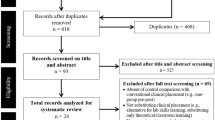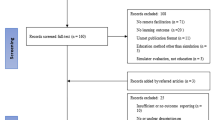Abstract
The paper reviews 50 years of research in health sciences education and identifies several recurring controversies—formative versus summative assessment, high and low fidelity simulation, expertise as knowledge versus skills, and the impact of teaching versus curriculum. I then look at the role these may play in the current situation where COVID has necessitated rapid change to distance learning. I then posit an essential role for research in teaching and learning, using multiple methods from qualitative to neuropsychological to better understand the dimensions of effective teaching. The ultimate goal is to operationalize these findings in creation of distance learning modules.


Similar content being viewed by others
References
Chetty, R., Friedman, J. N., & Rockoff, J. E. (2014). Measuring the impacts of teachers II: Teacher value-added and student outcomes in adulthood. American Economic Review, 104(9), 2633–2679.
Chi, M. T., Feltovich, P. J., & Glaser, R. (1981). Categorization and representation of physics problems by experts and novices. Cognitive Science, 5(2), 121–152.
Cook, D. A., Levinson, A. J., Garside, S., Dupras, D. M., Erwin, P. J., & Montori, V. M. (2008). Internet-based learning in the health professions: A meta-analysis. JAMA, 300(10), 1181–1196.
DeBruyckere, P., Kirschner, P. A., & Hulshof, C. (2019). More urban myths about learning and education. New York: Routledge.
Dorn, E., Hancock, B., Sarakatsannis, J. & Viruleg, E. New evidence shows that the shutdowns caused by COVID-19 could exacerbate existing achievement gaps.https://www.mckinsey.com/industries/public-and-social-sector/our-insights/covid-19-and-student-learning-in-the-united-states-the-hurt-could-last-a-lifetime.
Ellaway, R., Cleland, J., & Tolsgaard, M. (2020). What we learn in time of pestilence. Advances in Health Sciences Education, 25, 259–261.
Foisy, L., Matejko, A. A., Ansari, D., & Masson, S. (2020). Teachers as orchestrators of neuronal plasticity: effects of teaching practices on the brain (pp. 1–14). Hooboken: Mind, Brain and Education.
Frank, J. R., Snell, L. S., Cate, O. T., Holmboe, E. S., Carraccio, C., Swing, S. R., & Harden, R. M. (2010). Competency-based medical education: Theory to practice. Medical teacher, 32(8), 638–645.
Hanushek, E. A. (2011). The economic value of higher teacher quality. Economics of Education Review, 30(3), 466–479.
Harden, R. M., & Gleeson, F. A. (1979). Assessment of clinical competence using an objective structured clinical examination (OSCE). Medical Education, 13(1), 39–54.
Hattie, R. (2003). Teachers make a difference: What is the evidence? ACER report.
Hecker, K., & Violato, C. (2008). How much do differences in medical schools influence student performance? A longitudinal study employing hierarchical linear modeling. Teaching and Learning in Medicine, 20(2), 104–113.
Mayer, R. E. (2010). Applying the science of learning to medical education. Medical Education, 44, 543–549.
McGuire, C. H., & Babbott, D. (1967). Simulation technique in the measurement of problem-solving skills. Journal of Educational Measurement, 4(1), 1–10.
Monteiro, S., Sherbino, J., Sibbald, M., & Norman, G. (2020). Critical thinking, biases and dual processing: The enduring myth of generalisable skills. Medical Education, 54(1), 66–73.
Norman, G. (2002). Research in medical education: Three decades of progress. British Medical Journal, 324(7353), 1560–1562.
Norman, G., Dore, K., & Grierson, L. (2012). The minimal relationship between simulation fidelity and transfer of learning. Medical Education, 46(7), 636–647.
Norman, G. R., Monteiro, S. D., Sherbino, J., Ilgen, J. S., Schmidt, H. G., & Mamede, S. (2017). The causes of errors in clinical reasoning: Cognitive biases, knowledge deficits, and dual process thinking. Academic Medicine, 92(1), 23–30.
Rotgans, J. I. (2012). The themes, institutions, and people of medical education research 1988–2010: Content analysis of abstracts from six journals. Advances in Health Sciences Education, 17(4), 515–527.
Salomon, G., & Perkins, D. N. (1989). Rocky roads to transfer: Rethinking mechanism of a neglected phenomenon. Educational Psychologist, 24(2), 113–142.
Schuwirth, L. W., & Van der Vleuten, C. P. (2011). Programmatic assessment: from assessment of learning to assessment for learning. Medical teacher, 33(6), 478–485.
Servant-Miklos, V. F. (2019). Problem solving skills versus knowledge acquisition: The historical dispute that split problem-based learning into two camps. Advances in Health Sciences Education, 24(3), 619–635.
Shulman, L. S. (1986). Those who understand: Knowledge growth in teaching. Educational Researcher, 15(2), 4–14.
Stanovich, K. E. (2009). Matthew effects in reading: Some consequences of individual differences in the acquisition of literacy. Journal of education, 189(1–2), 23–55.
Sweller, J., Clark, R., & Kirschner, P. (2010). Teaching general problem-solving skills is not a substitute for, or a viable addition to, teaching mathematics. Notices of the American Mathematical Society, 57(10), 1303–1304.
Thorndike, E. L., & Woodworth, R. S. (1901). The influence of improvement in one mental function upon the efficiency of other functions. Psychological Review, 8, 247–261.
Wainman, B., Pukas, G., Wolak, L., Mohanraj, S., Lamb, J., & Norman, G. R. (2020). The critical role of stereopsis in virtual and mixed reality learning environments. Anatomical Sciences Education, 13(3), 401–412.
Author information
Authors and Affiliations
Corresponding author
Additional information
Publisher's Note
Springer Nature remains neutral with regard to jurisdictional claims in published maps and institutional affiliations.
Rights and permissions
About this article
Cite this article
Norman, G. Where we’ve come from, where we might go. Adv in Health Sci Educ 25, 1191–1201 (2020). https://doi.org/10.1007/s10459-020-10018-7
Received:
Accepted:
Published:
Issue Date:
DOI: https://doi.org/10.1007/s10459-020-10018-7




